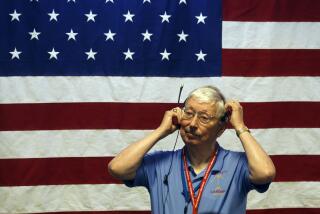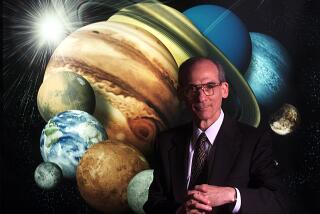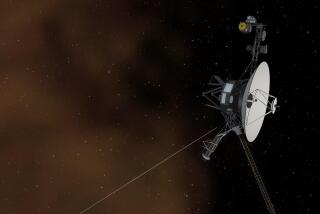Gravity May Lose Its Pull
It was in 1980 that John Anderson first wondered if something funny was going on with gravity.
The Jet Propulsion Laboratory physicist was looking over data from two Pioneer spacecraft that had been speeding through the solar system for nearly a decade.
Only something was off base. The craft weren’t where they were supposed to be.
Rather than traveling at a constant velocity of more than 25,000 mph toward the edge of the solar system, Pioneers 10 and 11 were inexplicably slowing down. Even factoring in the gravitational pull of the sun and its other planets couldn’t explain what he was seeing.
How could that be?
At first, Anderson figured there must be a simple explanation. Maybe there was a malfunction on board the spacecraft. Maybe his calculations were wrong.
Shy, bookish and soft-spoken, Anderson was not the type to call a news conference to announce that two U.S. spacecraft appeared to be disobeying the physical laws of the universe.
“I assumed something was going on that I didn’t understand,” said Anderson, now 70. “So I just kept at it.”
For years.
It was a lonely, often comfortless pursuit. Some critics pounded away at him for daring to question the conventional wisdom about the force that keeps our feet on the ground and the stars on their appointed rounds. Others questioned his math.
Two decades later, Anderson’s work on what is now called the Pioneer Anomaly may finally be paying off.
In October, a European Space Agency panel recommended a space mission to determine whether Anderson had found something that could rewrite physics textbooks. Some cosmologists even speculate the Pioneer Anomaly might help unravel some of the thorniest problems in theoretical physics, such as the existence of “dark matter” or mysterious extra-dimensional forces predicted by string theory.
For public consumption at least, Anderson and his close-knit group of researchers will not permit themselves the luxury of such grandiose speculation.
“I’m trying to stay away from” that kind of talk, said Slava G. Turyshev, a former Russian scientist who has been working on the anomaly for the last decade. “Even though I’m being dragged into it.”
However it turns out, the episode offers a rare glimpse into the scientific process at its rawest, most inspirational and gut-wrenching.
Whether Anderson will be remembered as the man who changed history or the guy who spent decades chasing an illusion, all that’s clear at this point is that he will be remembered.
*
For the record, gravity is one of the most closely studied forces in the universe.
Sir Isaac Newton first measured it in the 17th century. Every object in the universe attracts every other object, Newton determined, with a force proportional to the product of their masses and inversely proportional to the square of the distance between them. That means the bigger things are, and the closer they are, the greater their gravitational pull.
In 1915, a former Swiss patent clerk named Albert Einstein refined the theory, arguing that gravity occurs when planets or stars warp the fabric of space around them, much like a bowling ball on a trampoline warps the surface of the trampoline. Instead of a sucking force, Einstein’s general theory of relativity said small objects fall toward larger ones like a marble rolling down the slope of the trampoline to the bowling ball.
Einstein’s theory has been successfully tested again and again. Without it, complex space missions such as Pioneer 10 and 11 would have ended in disaster, either by missing their targets -- in this case fly-bys of Jupiter -- or by crashing.
Anderson was already an experienced space hand when the Pioneers were launched in 1972 and 1973. Having worked on the Mariner missions in the 1960s, he was chosen to be principal investigator for gravity research on both Pioneer missions.
It would prove to be a surprisingly long ride. The TRW-built Pioneers performed so well that after the initial two-year mission ended, NASA decided to send them on a new mission to explore the solar system’s outer planets.
They were the first spacecraft to travel through the asteroid belt, which some scientists at the time thought could be as dangerous as a field of icebergs. Pioneer 10 was first to pass the orbit of Pluto. For many years, until overtaken by the speedier Voyager 1, the Pioneers were the farthest venturing man-made objects in space.
By 1980, the vehicles were still zipping through space in fine shape -- when Anderson stumbled upon the unexpected.
“I started plotting this anomalous acceleration toward the sun,” Anderson said. In space science-speak, that meant the spacecraft were improbably slowing down.
To be sure, the anomaly was small, just 8 X 10--8 centimeters/second2. That amounted to about 8,000 miles a year, a tiny fraction of the 219 million miles the spacecraft covered annually. The anomaly is about 10 billion times weaker than the Earth’s gravity.
But over time, even inches and meters add up.
Today, after three decades, the difference is about 248,000 miles, the distance from Earth to the moon.
Anderson, ever the cautious scientist, didn’t tell anyone what he was seeing for a decade. Early on, the probes were still so close to the sun that he reasoned radiation and solar wind -- streams of ionized gas spewing forth through the solar system -- could be affecting them.
The other possibility was a spacecraft “systematic” -- an onboard mechanical problem. Prime suspects were gas leaks, along with releases of energy by the plutonium-powered radioisotope thermoelectric generators that provided electric power to the instruments.
None of these candidates seemed capable of producing errors as large as Anderson was charting.
There was one piece of evidence that seemed to support the idea that the anomaly could be real: It was almost exactly the same on both spacecraft. On the other hand, both Pioneers were built by the same company to identical specifications, so why shouldn’t the same problem show up on both?
As years passed, and the Pioneer probes moved away from the sun’s influence, the anomaly didn’t disappear -- or change even one iota.
Anderson was stumped. Unable to get the problem out of his head, he began spending his own time burrowing deeper into the numbers streaming back from space.
He was still scratching his head when physicist Michael Martin Nieto at the Los Alamos National Laboratory in New Mexico called up one day in 1994 looking for material for an upcoming speech about new developments in physics. Anything interesting going on?
“Well, I’ve got this thing with Pioneer,” Anderson said.
“I almost fell off my chair,” Nieto said.
*
That’s when, for good or ill, the Pioneer Anomaly went public. As word spread in the scientific world, critics appeared. This can’t be right, they said. You’ve got a software error. You’re not interpreting the data correctly. And there were the usual off-center conspiracy enthusiasts who were convinced that the researchers had found proof of aliens, God, or both.
Anderson assured the naysayers he was on their side. He wasn’t trying to throw stones at Einstein and Newton. The most likely answer, he agreed, was that a spacecraft systematic was causing the problem. The only thing was, in a decade of trying, he hadn’t found it.
Anderson’s work attracted another group, led by Turyshev, a young, hyperactive former Soviet scientist.
Turyshev, whose words tend to spill out faster than his tongue can keep up, fell in love with space by watching rockets -- launched from the super-secret Soviet site at Baikonur, Kazakhstan -- soar over his home in southern Siberia. Held in awe by colleagues for his expertise in relativity and other cosmological imaginings, he was the first Soviet scientist to leave his country for a job with JPL.
Though never funded by NASA to work on the anomaly, Turyshev plunged into the project as a volunteer, eventually becoming the Pioneer Anomaly’s door-to-door salesman. Carting around his own slide show, he traveled Europe seeking support for a space mission that could solve the riddle.
“This is a form of space archeology,” he said, explaining his devotion to the project.
The first sign that the world’s space bureaucracy was starting to take notice occurred in 1995, when NASA gave the research team a $247,000 grant to pay for an independent analysis of the Pioneer data. The Aerospace Corp., headquartered in El Segundo, was chosen.
“They came back and said, ‘Guys, you have something here,’ ” Turyshev said.
In 2002, Anderson, Turyshev, Nieto and other team members published the most detailed analysis of the Pioneer Anomaly. The dense, 54-page paper, which appeared in the peer-reviewed journal Physical Review, considered seemingly every conceivable space event: effects of solar radiation and solar wind, the force of radio beams used to communicate with Earth, gas leaks, helium leaks, and gravity from the Kuiper Belt, a region beyond Neptune that contains Pluto and a number of small, planet-like objects.
They even looked at whether ocean tides might affect NASA’s Goldstone Deep Space Network facility, where Pioneer’s radio transmissions were received. Though Goldstone, in the Mojave Desert, was many miles from the shore, it rested on California’s geologic Pacific plate. So, the team factored in the remote possibility that waves hitting the beaches were ever-so-slightly jiggling instruments at Goldstone.
But nothing came close to explaining the anomaly.
“There are two possible explanations,” Turyshev said. “The most plausible is systematics.”
The second possibility is new physics.
“If it’s new physics, the implications are truly tremendous,” he said.
*
So what would be the implications?
One possibility is that invisible, so-called dark matter is holding the spacecraft back. Some cosmologists believe that dark matter exists because only 10% of the expected mass of the universe has been found. If 90% of the universe’s mass and energy is invisible, maybe it could exert gravitational pull on spacecraft.
Another possibility, even more fanciful, is that invisible dimensions of space are tugging at the Pioneers. This idea has its origin in string theory, an idea that suggests we are surrounded by far more than the three dimensions we know about. Some versions of string theory suggest there may be as many as 11 dimensions, most of which are curled up and hidden from us.
As with dark matter, no hard evidence has been found proving the existence of vibrating strings far tinier than the smallest known particles.
A third possibility is that gravity has been hiding secrets that three centuries of research have failed to uncover.
Anderson and his colleagues have known for some time that the only way to prove the anomaly is to duplicate it with another spacecraft.
First, they considered other NASA missions that penetrated the outer solar system, finally settling on the 1989 Galileo and 1990 Ulysses. Although some data appeared to show the anomaly had affected the probes, results were not conclusive enough for Turyshev and Anderson.
A natural candidate was the twin Voyager missions, launched in 1977. The Voyagers’ meanderings offered plenty of space far out of the reach of the sun for the anomaly to show up, but their orienting technology was so different that the data were useless.
The only solution was a new space mission. But NASA wasn’t interested.
“We like planetary science,” Anderson said. Landing on planets and digging in the alien surface was the kind of hard science Americans preferred.
High-flown theoretical physics involving relativity had a more ready reception in Europe. So, slide show in hand, Turyshev hit the road.
This year alone, he has been to Europe four times. In October, the team was excited to learn that the European Space Agency’s Fundamental Physics Advisory Group had recommended an ESA mission to study the anomaly. That was the good news. The not-so-good news was that the launch wouldn’t happen before 2015, and the answer to the anomaly might not come back for decades more.
It’s unclear how many of the Pioneer team will be around to greet the new data. But if the anomaly turns out to be real, the story will be as much, if not more, about grinding persistence as the flash of insight that is supposed to be the badge of genius.
“Some have told us the most impressive thing was that we wouldn’t be stopped,” Nieto said. “We just keep going.”
Asked why he stuck with it all these years, Turyshev said it was the frustration of not being able to solve the problem.
Through all the years, Anderson has never permitted himself to hope he might have found something that could change the way people think about the cosmos. Or that his name would go down in history.
“I used to think the probability of making a fundamental discovery was pretty remote,” Anderson said. “Now, I kind of wonder about it.”
Whatever the solution to the Pioneer Anomaly, it will be reached without any more help from the Pioneers. NASA lost contact with Pioneer 11 in November 1995. Pioneer 10 sent its last message home in January 2003.
Anderson can’t help feeling a touch of sadness. “You do feel a loss.”
The spacecraft are now ghostly twins speeding through interstellar space. Pioneer 10 could reach the star Aldebaran in the constellation Taurus in about 2 million years, scientists say. Unless, of course, some uncharted force brings it to a halt, or twists its course toward some dark corner of space.






